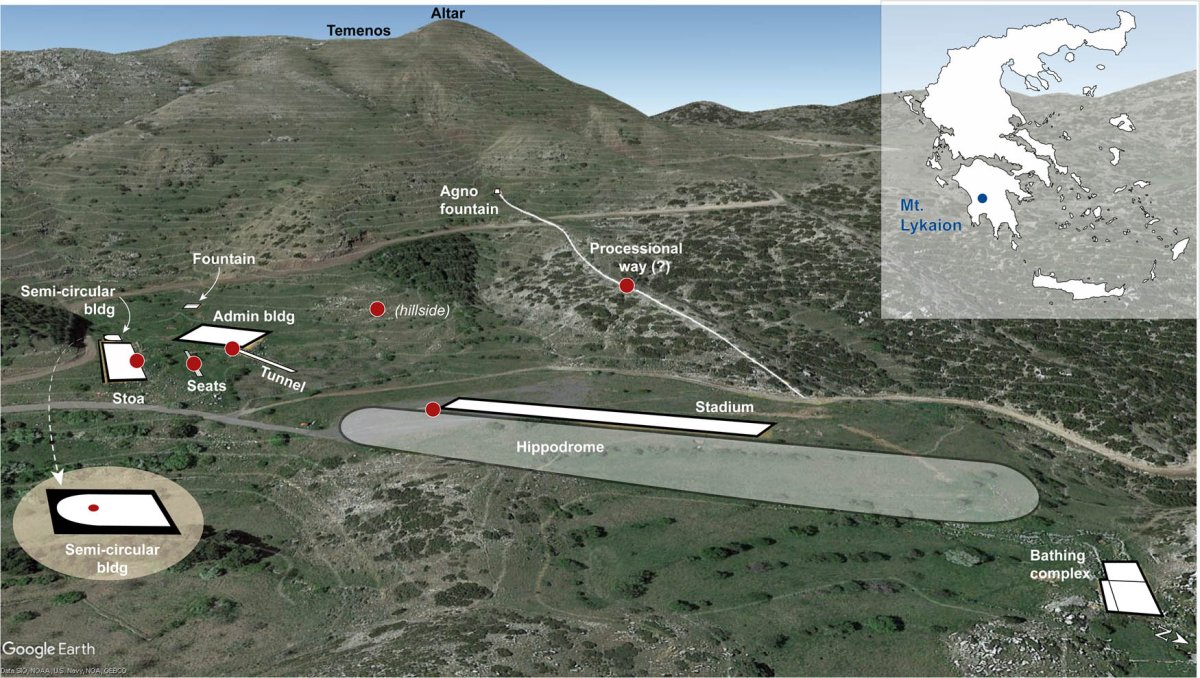Archaeologists have been “listening” to an ancient Greek sanctuary—and the research could shed new light on how the site was once used, according to a study.
Typically, investigations of historic sites have relied on what archaeologists can see. But in recent years, new techniques have emerged, enabling researchers to explore them in different ways using other senses.
One such method is known as “psychoacoustics”—a technique used to investigate how sounds are perceived by humans.
In the latest study, published in the journal Open Archaeology, researcher Pamela Jordan of the University of Amsterdam in the Netherlands employed psychoacoustics to explore the ancient sanctuary of Zeus on Mount Lykaion in Greece and investigate how it may have been used by contemporary visitors.
iStock
“What can we learn about a site’s distant past by listening to its current form? Psychoacoustics offers a promising, subject-centered approach in unlocking the sonic experience of past built spaces,” Jordan wrote in the study.
The sanctuary, which is located around 100 miles from Athens on Greece’s Peloponnese peninsula, was built into the southern peak of Mount Lykaion. It was one of the most renowned shrines in the ancient world. In ancient Greek mythology, the mountain was said to be one of the locations where the deity Zeus—who ruled as the king of the gods—was born and brought up.
At the southern peak of the mountain, which reaches an altitude of around 4,500 feet, sits the remains of an altar to Zeus consisting of a large mound of ashes with a retaining wall. The thick layer of ash is the result of centuries of ritual sacrifices in which animals—and potentially even some humans—were burned. Just below the altar are the bases of two columns and an open area identified as a temenos or “sacred precinct.”
Excavations at the altar have revealed evidence of human activity there as far back as around 5,000 years ago—centuries before Zeus was first thought to have been worshipped by the early Greeks. This suggests that there was an earlier tradition of devotion at the site to another, unknown, deity.
Other evidence uncovered within the sanctuary indicates that worship of Zeus at the site was established more than 3,000 years ago, in the form of drinking—and perhaps feasting—rituals.
Further down the peak from where the altars sits, located on a plateau, lie the remains of an ancient hippodrome, a stadium area and other structures related to an early athletic festival that took place in honor of Zeus every four years. The structures likely date to around the 4th century B.C. This festival rivaled a celebration that took place in the neighboring sanctuary of Zeus at Olympia—the site of the original Olympic Games.
Today, the architecture of the Lykaion sanctuary lies in ruin and there is very little evidence indicating activity at the site outside of large and infrequent gatherings, such as the athletic festivals. This is despite the fact that the site was “very likely” being used daily by local worshippers, according to the study.

P. Jordan/Open Archaeology 2023
In this context, employing psychoacoustic techniques that reveal how sounds interact between different structures can shed light on how the site was used in ancient times.
Between 2015 and 2022, the researcher and colleagues conducted four experiments in which they played pre-recorded sounds, ranging from white noise to speeches, at different points dotted across the site.
These sounds were recorded at another location within the site using two microphones positioned close together to mimic how human ears hear—a technique known as binaural recording. The researchers then used digital tools to help evaluate the sound frequency and clarity “heard” at different locations.
These recordings enabled Jordan and colleagues to show that the surface of the hippodrome reflected sound to both the audience within the venue and people who may have gathered at the hillside. This finding indicates that the hillside may have served as an important site for spectating.
Intriguingly, the study revealed that sound from the hillside could also be clearly heard in the hippodrome. If the hillside was used by spectators, this would have served an important purpose, according to the study.
“Spectating at that time in a ritual context was very active; it was an exchange with the athletes and the people who were actually conducting the ritual,” Jordan said. “So they needed the crowd input as part of this reciprocal relationship.”
On a smaller scale, the team also employed psychoacoustic techniques in a small, semi-circular building of unknown function. They found that the space would have likely created a “heightened sonic environment” distinct from any other part of the sanctuary that may have reinforced one’s movements.
Such a sonic environment could have been significant if the building originally functioned as a sacred space, especially if sound-making played any role in the ritual activities within, according to the study. Sound-based practices were associated with the cult worship of another Greek deity known as Pan, particularly in caves and grottos, Evidence of the worship of this god appears to originate on the mountain in the sixth century B.C.
However, Jordan said any conclusions drawn from such early psychoacoustic results should be interpreted with caution. It is not yet known whether the sonic effects the team observed were intentional. And even if they were, our modern interpretation of these sounds may be different to those of the ancient Greeks who frequented the site.
Nevertheless, the researcher said she is hopeful these methods will be used more frequently in the years to come, and that she would like to use them to explore other sites in future.
Uncommon Knowledge
Newsweek is committed to challenging conventional wisdom and finding connections in the search for common ground.
Newsweek is committed to challenging conventional wisdom and finding connections in the search for common ground.


